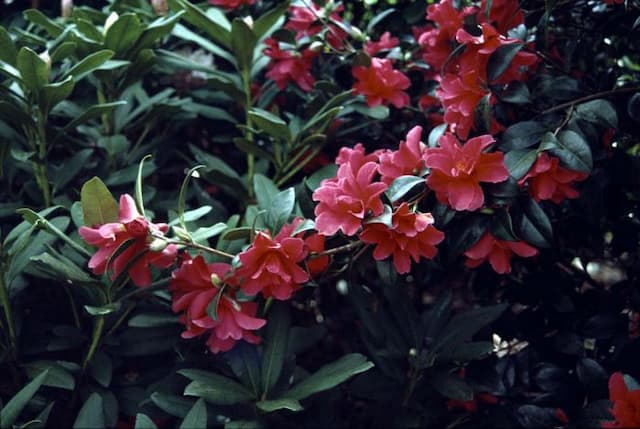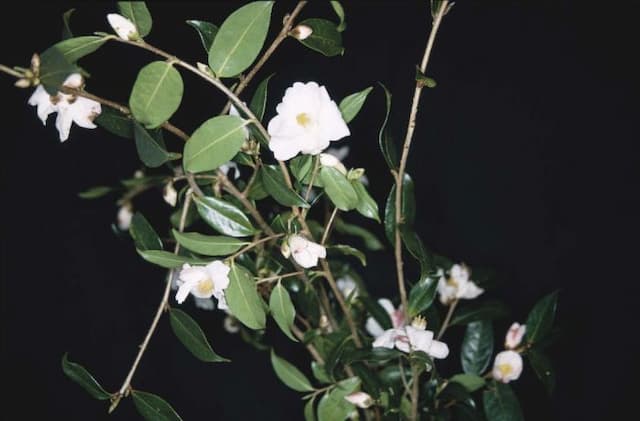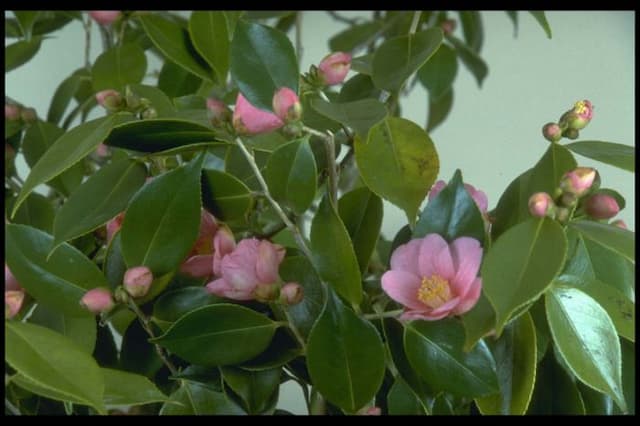Bow Bells Camellia Camellia × williamsii 'Bow Bells'

ABOUT
The 'Bow Bells' is a stunning ornamental plant known for its striking flowers that make it a favorite among gardeners. Its appearance is characterized by glossy, evergreen leaves that provide a lush backdrop for the showy, soft pink blooms. The flowers are noted for their delicate, shell pink hue, which can add a touch of elegance to any setting where the plant is grown. The 'Bow Bells' blooms typically emerge in the early to mid-spring, although flowering times may vary slightly depending on the local climate and conditions. Each flower comprises numerous petals that are elegantly arranged to form a peony-like shape, giving them a full and rounded appearance. This attractive formation of the petals creates a romantic and soft visual impact. The leaves of the plant are dark green, leathery, and have a somewhat shiny surface, which gives the foliage a lively and vibrant look throughout the year. Their shape is usually elliptical with a slightly serrated edge, which contrasts nicely with the softness and roundness of the flowers. As an evergreen, 'Bow Bells' retains its beautiful foliage across the seasons, providing a constant green presence in gardens. The leaves are arranged alternately along the stems, creating an orderly and neat plant habit. In addition to the pleasing aesthetic of its flowers and foliage, 'Bow Bells' may also attract various pollinators such as bees and butterflies, adding to the charm and ecological value of the plant in a garden setting. Overall, the 'Bow Bells' is celebrated for its enchanting appearance and the effortless beauty it brings to any landscape where it is planted.
About this plant
 Names
NamesSynonyms
Bow Bells Camellia.
Common names
Camellia × williamsii 'Bow Bells'.
 Toxicity
ToxicityTo humans
Williamsii camellia is not considered toxic to humans. In general, members of the Camellia genus are not known for being poisonous, and there are no well-documented cases of toxicity from ingesting parts of this plant. However, it is always advisable to discourage children from eating any plant material, as individual reactions can vary, and some people might be sensitive or allergic to certain plants.
To pets
Williamsii camellia is generally considered non-toxic to pets, including cats and dogs. It is not known to cause poisoning if ingested by animals. However, it is always wise to keep an eye on your pets and prevent them from eating large quantities of any non-food plant material, as it could potentially cause gastrointestinal discomfort or an unexpected allergic reaction.
 Characteristics
CharacteristicsLife cycle
Perennials
Foliage type
Evergreen
Color of leaves
Dark green
Flower color
Pink
Height
6-10 feet (1.8-3 meters)
Spread
5-8 feet (1.5-2.4 meters)
Plant type
Shrub
Hardiness zones
7-9
Native area
East Asia
Benefits
 General Benefits
General Benefits- Aesthetic Appeal: Camellia 'Bow Bells' offers beautiful pink flowers that enhance the visual appeal of gardens and landscapes.
- Seasonal Interest: Blooms in late winter to early spring, providing color during a season when few other plants are flowering.
- Privacy Screen: Can be used as an evergreen hedge or screen, offering year-round privacy.
- Habitat Support: Provides nectar and pollen for bees and other beneficial insects during its flowering season.
- Landscape Versatility: Works well in various garden styles, including formal, woodland, and cottage gardens.
- Low Maintenance: Once established, Camellia 'Bow Bells' requires minimal care, making it a practical choice for gardeners of all levels.
- Durability: It is a hardy plant that can withstand various environmental conditions when properly situated.
- Long Lifespan: Camellias are known to live for many years, even decades, providing long-term enjoyment.
 Medical Properties
Medical PropertiesThis plant is not used for medical purposes.
 Air-purifying Qualities
Air-purifying QualitiesThis plant is not specifically known for air purifying qualities.
 Other Uses
Other Uses- Art inspiration: Artists and photographers often use the delicate flowers of Camellia williamsii 'Bow Bells' as a subject in their work, capturing its beauty in various mediums.
- Fabric dye: The petals can be used to create a light pink or cream dye for fabrics, giving garments a unique and natural color.
- Floral arrangements: The flowers make exquisite additions to floral arrangements and bouquets, offering a touch of elegance.
- Garden architecture: It can be trained to grow against a wall or a trellis, creating a living piece of garden architecture.
- Landscape design: The plant is often used in landscape design, not just for its flowers, but for its evergreen foliage which provides year-round interest.
- Lei making: In some cultures, the flowers can be strung together to create fragrant and beautiful leis or floral necklaces for special occasions.
- Symbolic gestures: In certain regions, Camellia williamsii 'Bow Bells' is given as a gift of admiration or affection due to its beautiful blooms.
- Macro photography: The unique structure of the flower lends itself well to macro photography, which can showcase the intricate details of its petals and structure.
- Thematic gardens: The plant is used in thematic gardens such as romantic or Victorian gardens, where its old-fashioned charm is appreciated.
- Wedding decor: Its flowers can be used to adorn wedding venues or be incorporated into bridal headpieces and centerpieces.
Interesting Facts
 Feng Shui
Feng ShuiThe Camellia is not used in Feng Shui practice.
 Zodiac Sign Compitability
Zodiac Sign CompitabilityThe Camellia is not used in astrology practice.
 Plant Symbolism
Plant Symbolism- Admiration: Camellias generally symbolize deep admiration for someone. The delicate and attractive appearance of the 'Bow Bells' blooms signifies the beauty seen in the person being admired.
- Perfection: With its perfect-looking flowers, Camellia 'Bow Bells' is often associated with the idea of perfection and an unattainable ideal.
- Longevity: Camellia plants are known for their long life and hardiness. Thus, the 'Bow Bells' variety can symbolize the wish for a long and healthy life.
- Love: Camellias are also linked with love, and giving someone Camellia 'Bow Bells' could be a way to express romantic desire or deep affection.
- Gratitude: Gifting Camellia 'Bow Bells' may symbolize gratitude, indicating appreciation and thanks for someone’s help or friendship.
 Water
WaterWilliamsii camellias need consistent moisture but should not be waterlogged. Water young plants with about 1-2 gallons per week, ensuring the soil is moist but not saturated. Mature shrubs require deep watering every 2 to 3 weeks during dry periods, allowing the soil to dry out slightly between watering sessions. During the winter, reduce the frequency as the plant's growth slows down and its water requirements decrease. Always avoid overhead watering to prevent leaf diseases, and aim to water the plant at the base instead.
 Light
LightWilliamsii camellias thrive in partial shade with filtered sunlight. They can also tolerate full sun in cooler climates but need protection from the hot afternoon sun in warmer areas. The ideal location is underneath high trees with dappled sunlight or on the north or east side of a building where they receive morning light and afternoon shade.
 Temperature
TemperatureWilliamsii camellias prefer a temperate climate with temperatures ranging between 40-85 degrees Fahrenheit. They can withstand occasional dips down to the low 20s but are at risk of cold damage if temperatures fall below 20 degrees Fahrenheit. The ideal temperature range for flourishing growth is between 50-72 degrees Fahrenheit.
 Pruning
PruningPrune williamsii camellias to maintain their shape, remove dead or weak wood and to promote air circulation which helps prevent disease. Prune immediately after flowering since they set their buds shortly after new growth begins. It's generally not necessary to prune every year; do it every two or three years, or as needed to control size and shape. The best time for pruning is in late winter or early spring before the plant starts its new growth.
 Cleaning
CleaningAs needed
 Soil
SoilThe best soil mix for Williamsii Camellia 'Bow Bells' is acidic with a pH of 5.5-6.5, well-draining, and rich in organic matter. A mix of 50% peat moss, 30% pine bark, and 20% perlite or coarse sand is ideal for good root health.
 Repotting
RepottingWilliamsii Camellia 'Bow Bells' should be repotted every 2-3 years. It's best done in spring before the growing season, ensuring minimal disruption to the flowering cycle.
 Humidity & Misting
Humidity & MistingWilliamsii Camellia 'Bow Bells' thrives in moderate to high humidity levels, around 50-80%. They prefer a humid environment, which can be achieved by placing the pot on a tray with wet pebbles.
 Suitable locations
Suitable locationsIndoor
Provide bright, indirect light and keep evenly moist.
Outdoor
Sheltered spot, morning sun, well-drained acidic soil.
Hardiness zone
7-9 USDA.
 Life cycle
Life cycleThe Camellia × williamsii 'Bow Bells', commonly known as Williamsii Camellia, begins its life when a seed germinates in well-drained, acidic soil with a good amount of organic material. The seedling slowly grows into a young plant, developing a root system and foliage over several months. As it matures into a bushy shrub, the plant experiences vegetative growth, producing glossy, evergreen leaves and starting to develop buds. In late winter to spring, depending on the climate, the Williamsii Camellia produces its signature waxy, pink flowers that attract pollinators. After pollination, the flowers develop into seed pods if conditions permit, which then dry and release seeds to propagate the next generation. Between flowering periods, the plant enters a period of maintenance where it continues leaf growth, and with adequate care, it can live for many decades.
 Propogation
PropogationPropogation time
Spring-Early Summer
Propogation: The Camellia × williamsii 'Bow Bells', more commonly known as the Williamsii camellia, is often propagated through semi-hardwood cuttings. This method is typically undertaken during the late summer or early autumn months when the new growth has started to firm up. To propagate by cuttings, a gardener would select healthy, semi-hardwood stems and cut a section that is about 4 to 6 inches (10 to 15 centimeters) long. The leaves on the lower half of the cutting are removed and the cut end is often dipped in a rooting hormone powder to encourage root growth. The cutting is then placed in a pot filled with a mixture of peat and perlite or a suitable propagating mix. The environment needs to be kept humid, and the pot should be placed in indirect light. Over a period of several weeks to a few months, the cutting should develop roots and can then be transplanted into a more permanent location.









